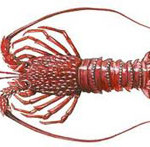
Haliotis midae
Abalones are slow growing, herbivorous marine snails. They belong to a large class of molluscs (Gastropoda) with single-structured shells. There are over 100 species worldwide in the single genus Haliotis, which means ‘sea ear’, a reflection of the flattened shape of the shell. It is no surprise then that it is called ‘Oreille de Mer’ in France. Abalone shells can be oval or rounded, with a row of respiratory pores and large dome towards one end. They are edible molluscs and considered a delicacy.
The strong, muscular foot generates enough suction to allow the abalone to fix itself firmly to rocky surfaces, and enables it to withstand the strong buffeting of the waves. They are found from the intertidal to the depth limit of marine plants, some 80 -100m, from tropical to cold waters. The feed mostly on seaweed, which they trap by marginally raising the front end of the ‘foot’, and when a piece of seaweed drifts underneath, the foot clamps down on it.
There are six species of South African abalone, of which the perlemoen (Haliotis midae) is the largest and most commercially important. It is also the most abundant species in the region and as a result it is the only species around which a commercial fishery has developed. The fishery has suffered heavily from illegal poaching and is in danger of collapse.
The perlemoen is distributed from St. Helena Bay to Port St. Johns. There is a possibility of reseeding natural populations in the future. The shell of a perlemoen grows to a length of 200 mm. The outside, which is covered in irregular ridges radiating from the slightly raised apex, ranges from purplish brown to grey. The inside is iridescent mother-of-pearl. The common name of ‘perlemoen’ is a corruption of the Afrikaans word ‘perlemoer’ meaning mother-of-pearl.








Social Profiles